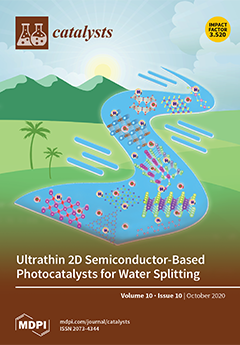A comprehensive mechanistic insight into the photocatalytic reduction of CO
2 by H
2O is indispensable for the development of highly efficient and robust photocatalysts for artificial photosynthesis. This work presents first-principles mechanistic insights into the adsorption and activation of CO
2 in the absence and presence of H
2O on the (001), (010), and (110) surfaces of tantalum nitride (Ta
3N
5), a photocatalysts of significant technological interest. The stability of the different Ta
3N surfaces is shown to dictate the strength of adsorption and the extent of activation of CO
2 and H
2O species, which bind strongest to the least stable Ta
3N
5(001) surface and weakest to the most stable Ta
3N
5(110) surface. The adsorption of the CO
2 on the Ta
3N
5(001), (010), and (110) surfaces is demonstrated to be characterized by charge transfer from surface species to the CO
2 molecule, resulting in its activation (i.e., forming negatively charged bent CO
2−δ species, with elongated C–O bonds confirmed via vibrational frequency analyses). Compared to direct CO
2 dissociation, H
2O dissociates spontaneously on the Ta
3N
5 surfaces, providing the necessary hydrogen source for CO
2 reduction reactions. The coadsorption reactions of CO
2 and H
2O are demonstrated to exhibit the strongest attractive interactions on the (010) surface, giving rise to proton transfer to the CO
2 molecule, which causes its spontaneous dissociation to form CO and 2OH
− species. These results demonstrate that Ta
3N
5, a narrow bandgap photocatalyst able to absorb visible light, can efficiently activate the CO
2 molecule and photocatalytically reduce it with water to produce value-added fuels.
Full article





